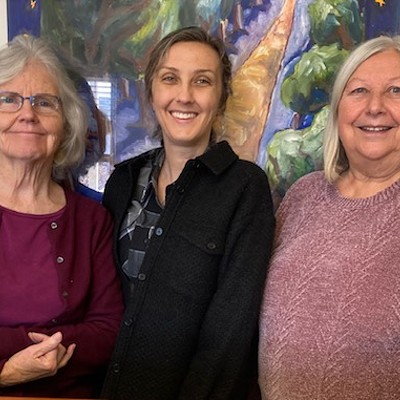Published May 7, 2003 at 4:00 a.m.
No utility poles or wire mar the final mile to Paul and JoAnne Kenyon's Bridport home. The mildly undulating landscape of trees and fields is uninterrupted but for a single slender wind turbine spinning lazily in the gentle valley wind. Out in the middle of what Paul calls "Vermont's Big Sky country," the Kenyons live off the grid. Only the road and an underground telephone line connect them to the outside world. They engineer their own energy, gather their own water and manage their own waste.
Paul, who is 54, has a degree in engineering and a talent for carpentry. He designed and built virtually every inch of the house, and has used his engineering skills to install the wind and solar systems that supply the home's electricity.
While wind power has gotten a lot of press lately, the focus has been on large mountaintop, industrial-strength, grid-geared projects. Less attention has been given to the "small wind" industry, in which relatively low-power machines on modest towers supply energy to individual households. There's a good -- and growing -- global market for this technology, but it's been slow to catch on in Vermont. Colin Kerr, an engineer at Burlington-based Windstream Power Systems, says his company has been in the wind business for 28 years, but "the vast majority of our sales have been out of state and overseas." With the current spotlight on Vermont's wind energy potential, and growing consumer awareness of the human and environmental costs of fossil fuels, small wind's moment may be at hand.
Approaching the Kenyons' place from the north, the only visible sign of the house is a long-severe stretch of roof that veers skyward in a blank, dark slope. This is intentional. "The house is part of the system," Paul explains. The roof is designed to shuck off the winter's chill winds. The south-facing side presents a friendlier face: broad windows and a greenhouse suck in warmth from the sun during the winter. In the summer, the roof's large overhang provides shade. These passive-solar design elements eliminate any need to actively heat or cool the house, Paul says. "Before we ever installed electricity, we had already reduced what we needed to use."
The Kenyons get most of their electricity from a small wind machine set atop a guyed 93-foot tower. They bought the machine used. "It's an old technology," says Paul. And apparently a long-lasting one. On a recent trip through Montana, Kenyon saw an identical machine that had been cranking out energy, unserviced, for 50 years. The rotors on the Kenyons' machine are connected to a generator that cranks out electricity when the wind blows. Breezes over 10 miles per hour provide usable energy as direct current.
When the turbine first went up, the Kenyons used DC appliances that drew power directly from the skies. It wasn't a perfect system. With no mediating apparatus, electrical output was as variable as, well, the wind. Light bulbs flickered like candles. After a year, Paul installed a battery sink. Like a dam in a river, 20 interconnected batteries now collect the wind's erratic direct current, which is then converted to a steady alternating current outflow. The batteries also store surplus energy, which can be tapped when the air is still.
The battery sink lives in an attic room whose floor, walls, and peaked ceiling are painted a soothing Caribbean blue. In this dual-use "energy room," Joanne -- a massage therapist and a certified practitioner of Brennan Healing Science -- does her own energy work, as she puts it, "using my hands for healing." The battery sink is 20 deep-cycle golf-cart batteries in maroon plastic cases nested in a shallow well. From time to time they creak with percolating electricity. The batteries' collective storage capacity is enough to support the Kenyons through a windless week.
An array of solar panels also backs up the turbine and feeds electricity into the same battery sink. One might wonder at the practicality of depending on the sun in a state with a six-month winter. But while Vermont might not hold the title of "Sunshine State," the Green Mountains get 80 percent of the sunshine Florida does.
Solar and wind systems make "a good mix" in New England, Paul says. Clear, sunny winter days usually have little or no wind, while windy days tend to have little sun. "It's just the way the weather works," Paul says. Should both sun and wind fail, the Kenyons can fall back on a propane generator. Judging from the dust, it doesn't get much use.
Electricity isn't the only issue facing folks who build off-grid. They also have to deal with getting water and disposing of waste. The Kenyons channel rainwater from the roof of their shed into a cistern below the house. Even taking acid rain into account, rainwater can be cleaner than groundwater, which can be thick with pesticides and other contaminants, especially in farm country. As for the rain, "we choose our storms," JoAnne says. They don't gather water, for example, from the storms that blow in from Ohio.
Waste presents more of a challenge. The Kenyons, who are unwilling to use the earth as a sink, have long had plans to incorporate a self-composting toilet into the house. One model they tried was supposed to compost using "spaghnum moss and air and time," but instead it attracted fungus flies, and didn't cope well with the cold. For now the Kenyons are using an outhouse.
But theirs is not just any closet-in-the-woods. Designed by Paul after a model he saw at an exposition in Maine, it has a door that's almost all window, which gives the closet-sized room a light, almost lofty feel. And it's cozy enough to put on a Christmas card. In fact, this winter Paul and JoAnne sent their friends a card with the following haiku:
Foot prints in the snow
hard to get there just to go
thanks for the warm seat
The only trouble is that it calls for disciplined bowels. The outhouse is strictly for solid matter -- for the other, there's a bidet inside. When the drawer below the seat is full, it's carried to a solar dehydrator where, over several months, the sun dries out the shelf's contents, destroying pathogens and speedily composting the Kenyons' excrement to dirt. As long as you're reasonably strict about your excretions, and generous with sawdust, the outhouse stays odor-free. The system isn't for everyone. "One of the first things my mother did when I moved in," JoAnne recalls, "was give us a port-o-potty."
JoAnne, herself, who moved into the house two years after Paul did, wasn't immediately sold on the place, which still looked like a rough camp the first time she saw it. "I said, 'Boy oh boy, I wouldn't like to live here.'" The first winter Paul was there, she reports, a gallon of water froze just a few feet from the wood stove.
Paul agrees that building off the grid was a rocky experience. Beginning with the building's inspiration 20 years ago around a campfire in Africa, progress on the home has been glacial, with every small step in improved amenities amounting to "a quantum leap towards the present." He still calls the house a work in progress. Many of the technologies available to today's energy-conscious builders are based on the trial-and-error experiences of people like the Kenyons.
Renewable systems can also be costly. Though the Kenyons' solar array cost relatively little -- about $2,500 -- Jason Monaco, sales manager at Montpelier-based Solar Works Inc., suggests that the price can run as high as $20,000. A new wind system goes for anywhere from $3,000 to $40,000. Even so, for off-grid sites, the expense may be less than the cost of extending utility lines. At about $8 per foot for overhead extensions, and $10 to $12 per foot for underground wires, the price tag can be prohibitive for folks building far from the nearest power lines.
All things considered, Paul is convinced that renewable energy is worth the cost. "This technology enables me to take advantage of any piece of property on the planet." Plus, Vermont provides a few financial incentives for investing in alternatives. Renewable energy systems and net metering equipment, which allow on-grid green energy users to sell energy back to power companies, have recently been granted exemption from the state's 5 percent sales tax.
Paul notes that when people pay for fossil fuels and nuclear power, "We're not paying full price for our energy." Hidden costs -- to the environment, to people in oil-producing countries, and to the future -- don't show up on a utility bill. "Right now, Iraqis are paying the price for our cheap energy," Paul points out.
Considering what fossil fuels and nuclear power cost the world in the long-run, they're "very, very cheap" for consumers. As he sees it, when you put money down for wind and solar energy, you pay something closer to the appropriate cost of energy, rather than living "off the future's nickel."
On a more personal level, JoAnne observes, living off the grid forces you to pay attention to things the rest of us take for granted: what's supplying the juice at the other end of the electric outlet; where your drinking water's coming from; where and when you poop and pee. "It does bring us a lot closer to the reality of the impact we human animals have on the planet," she muses. "We're aware of it all the time.
More By This Author
Speaking of...
-

Stamford Wind Proposal Tests Whether Large Turbines Have a Future in Vermont
Nov 22, 2023 -

Vermonters Look for Cheaper Ways to Keep Their Homes Warm This Winter
Nov 9, 2022 -

Regulators Are Poised to Let Vermont Gas Buy Methane From a Distant Landfill
Oct 21, 2022 -

Video: Talking Trees With Burlington Arborists
May 5, 2022 -

Increasing Downpours Impede Efforts to Improve Lake Champlain's Water Quality
Aug 18, 2021 - More »
Comments
Comments are closed.
From 2014-2020, Seven Days allowed readers to comment on all stories posted on our website. While we've appreciated the suggestions and insights, right now Seven Days is prioritizing our core mission — producing high-quality, responsible local journalism — over moderating online debates between readers.
To criticize, correct or praise our reporting, please send us a letter to the editor or send us a tip. We’ll check it out and report the results.
Online comments may return when we have better tech tools for managing them. Thanks for reading.









































